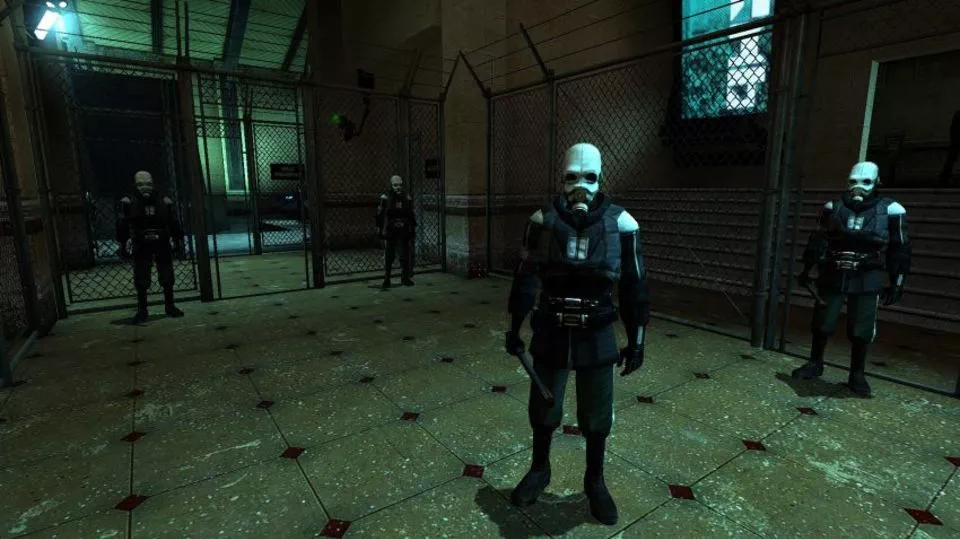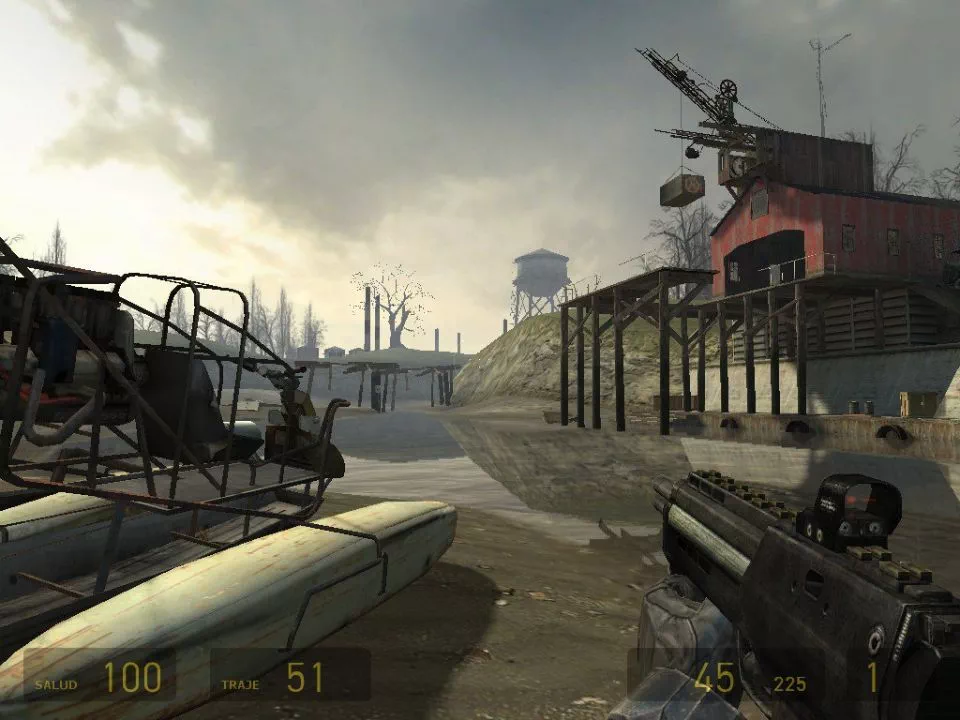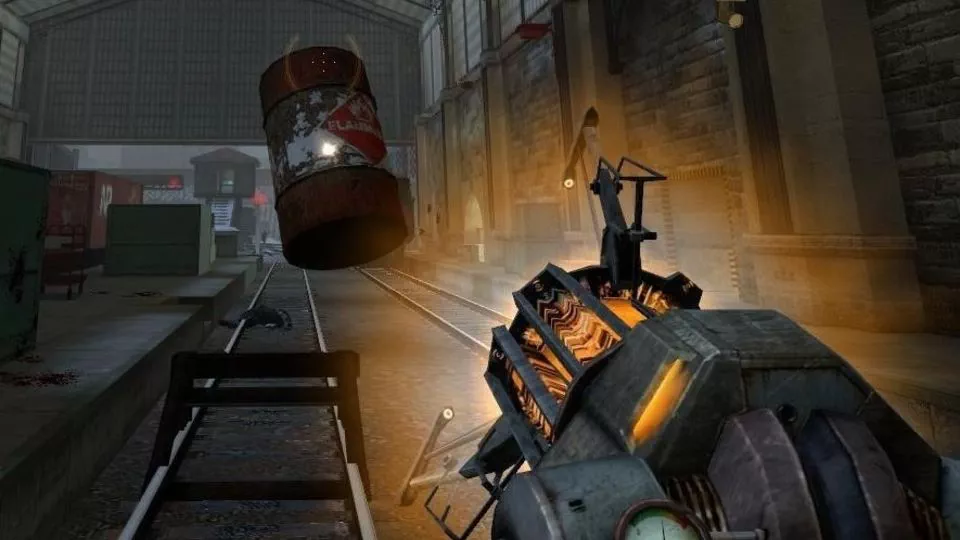Portal - Game Review
Introduction Portal is a first-person puzzle...
By Zora Flatley2314

0

Introduction
If there’s one name in the PC gaming industry that is known to most, if not all, gaming aficionados, it’s Half-Life 2. Not even Half-Life although the original was just as exceptional as its successor. Part of this is due to the immense controversy regarding Valve’s failure to produce a the oft demanded Half-Life 3, but Half-Life 2 remains an incredibly strong game under it’s own power.
I’d heard of Half-Life 2 since I’d entered the PC gaming arena and acquired it a few years back during a package deal during a Steam sale, but I never really got around to finishing it until a few days ago. I’d played around with it a bit, but a few issues I had with it, which I’ll get to eventually, stopped me from pushing through until recently. Having finished it though, I can openly say that Half-Life 2 is well deserving of all the praise it receives.
Half-Life 2 was originally released in 2004 by Valve as a sequel to the 1998 game, Half-Life. Half-Life 2 is an action-adventure puzzle game, but it is also a first-person shooter, in a relatively rare combination. It currently enjoys an “overwhelmingly positive” average review on Steam, and a 96/100 according to Metacritic for the PC version.
Just as a note for readers here, I try to avoid major spoilers in this review, but some content will be revealed that would definitely be more satisfying if players discover it on their own, so I highly recommend that future players play the game before reading this review, lest they ruin some of Half-Life 2’s incredible reveals accidentally.
Story and Content
At its core, Half-Life 2 is a story-oriented game, with strong gameplay aspects, but the key feature for consideration in Half-Life 2 is actually its richly detailed and immersive world-building. The player is given zero context before they’re plunged into the game, so they have to think on their feet quite often to determine the exact state of affairs.
When I played Half-Life 2, my first assumptions were somewhere along the lines of an Orwellian police state and a classic resistance plotline, but I quickly discovered that wasn’t the case amidst the hints of futuristic technology, alien creatures, and even zombie-like monsters overrunning both the human public and the oppressive Combine ruling over them.
In a way, Half-Life 2 plays very much like a traditional police state story, with the protagonist Gordon Freeman acting as a key resistance fighter working to undermine the mysterious Combine that rules the world with an iron fist, but as the player travels the world and uncovers more of the story, they slowly start to discover stranger and stranger details, like the possibility of interdimensional travel and the idea that the Combine are actually from another world.
More than anything, Half-Life 2’s world is both mysterious enough to be enjoyable in exploring, and familiar enough for it not to cause any hurdles to new players trying to get their bearing. Concepts like oppression, revolution, resistance are all familiar to most gamers, and the inclusion of the advanced sci-fi concepts Half-Life 2 brings in add a unique twist that make the story different to other incarnations of Orwellian dystopia.
Not to mention that it creates the possibility for incredibly fun gameplay mechanics. The only issue with Half-Life 2’s story is its first-person nature, although that really acts as a double-edged sword in this case. Playing in the first-person makes the game incredibly immersive for the player; as opposed to having the player relate to Gordon Freeman as a person, they play as Gordon Freeman, and become that character.
However, the downside of this is that, since the story is incredibly linear (almost too linear at times) the player doesn’t actually speak, with possible dialogue choices compromising Gordon’s character. This isn’t exactly new, other Valve games like Portal have silent protagonists, and games like Pokémon have made do with that as well, but when the story being as essential as it is to Half-Life 2, having some dialogue on the part of Gordon Freeman, and maybe even seeing his face, would definitely have helped create a stronger plot and more richly developed character in Gordon Freeman.
Still, I wholeheartedly support Valve’s decision to make Gordon the faceless nameless character he is, in the name of gameplay immersion for players.
 https://revyou.com/uploads/thumbnail-960/1592027178889half-life-2-10243-1.webp
Half-Life 2 - Review
https://revyou.com/uploads/thumbnail-960/1592027178889half-life-2-10243-1.webp
Half-Life 2 - Review https://revyou.com/uploads/thumbnail-960/1592027178890QyZ5QzwDyjoMMHJNZ9GyHF-1200-80.webp
Half-Life 2 - Review
https://revyou.com/uploads/thumbnail-960/1592027178890QyZ5QzwDyjoMMHJNZ9GyHF-1200-80.webp
Half-Life 2 - Review
Gameplay
Although Half-Life 2’s strongest aspect is its story and worldbuilding, there’s not really much to say about its story without explicitly ruining the twists and turns that make the reveals in the end so satisfying. On the other hand, Half-Life 2’s gameplay is very unique and is a big part of what makes the game what it is.
The game primarily deals with following the story, but the way it does so is different to many other story games. Half-Life 2 has close to no written exposition, besides the titles of chapters that serve as level separators; Gordon doesn’t speak and is only given vague instructions by NPCs as to where he should go or what he should do, and the HUD display is purely informational, only displaying weapons and health information.
It’s the game’s design that makes it possible with the geography of the levels subtly guiding the player onwards. The levels are cleverly designed, making the map seem huge (showing off the huge landscape of City 17 or the vast countryside during the external levels) while maintaining the small size handled by the game’s engine.
The levels are all designed to push the player in the direction of the story, with no real exits to the level except where you came from, which is often blocked off, and where you’re going, which is the objective. Even if the player has no idea what they’re doing and slept through all the NPC interactions, the game is still highly playable using minimal trial and error, by just walking around, solving puzzles, and fighting enemies.
Speaking of which, as a first-person shooter in a resistance story, fighting plays a large role in Half-Life 2. Throughout the story, Gordon slowly acquires weapons and tools to fight his way through the levels, which are slowly populated with tougher enemies, strong weapons, and more strategically taxing setups.
Most of the time, Gordon has to either eliminate Combine soldiers or monsters, each of which requiring separate strategies, weapons, or preparation, with good aiming and shooting skills for both. Although the game isn’t specifically focused on the shooting aspect, being able to fire and operate Gordon’s various weapons and tools is often key to being able to escape levels and defeat required enemies, although players can often perform just as fine by running past most of the enemies in question.
The weapons themselves are a different story, however. Gordon acquires a maximum of ten different tools that he can use, with some of them, like the crowbar and the gravity gun becoming iconic of Half-Life 2. Again, the player has freedom of choice regarding which weapons to use, although some are generally more practical than others in certain situations, most of which NPCs freely point out.
Half-Life 2 is also filled with a variety of interesting puzzles, most of which focused on advanced physics and simulations. The gravity gun is especially helpful in this regard, and it even becomes the main tool of advancement in the endgame, with Gordon’s other weapons being confiscated by the Combine.
The gravity can be used to manipulate objects while disregarding gravity, carrying heavier objects than Gordan can independently lift, and blasting even heavier objects using bolts of energy. Using the gravity gun and Gordon’s own lift power (whether he “lifts” or not is still up for debate), the player solves puzzles like balancing weights on a lever to reach high places, stacking floating barrels to cross electrified pools of water, and even playing catch with a giant mechanical dog.
I genuinely enjoyed playing around with Half-Life 2’s physics engine; most story-based games, including modern ones, often include physics as a purely aesthetic component, or one of secondary importance to game mechanics like bullet travel and trajectory.
Half-Life 2’s physics doesn’t require any previous knowledge of real-world physics, but it does encourage players to think creatively and use their surroundings, which can be helpful in battle situations as well, like blasting explosive gas canisters at enemies using the gravity gun for example, or activating traps to use against zombies, for example. My only issue about Half-Life 2’s physics usage was its lack of fulfillment of its potential.
Playing around with some of the objects in the game showed me just how versatile Havok (the engine behind most of the physics in Half-Life 2) was, and I felt like there was so much more that could have been done, with puzzles possibly incorporating the different gun mechanics perhaps. In any case, the puzzles remained very diverting, and I was very pleased to have to put aside my guns and pull out the trusty crowbar and gravity gun whenever crates needed smashing, or the environment needed manipulation.
However, I cannot deny the fact that I’d actually dropped Half-Life 2 during my first playthrough a few years ago, and upon replaying it I found myself facing similar issues: excessive grind. Throughout some of the travel levels and the action levels, I found myself getting exhausted quickly and feeling as though I was just wading through hordes of enemies with little reward, especially at the roughly 75% mark, where I’d dropped the game the first time.
Usually this issue was resolved whenever I got to my destination and found other NPCs ready to advance the story and discover more of what I was supposed to do, but whenever I found an NPC yelling at me to travel to another far off location all on my own, I got this feeling of sinking despair at having to grind for another half hour or forty-five minutes before I got to figure out what happened next in the story.
I’m sure if I wasn’t as immersed in the story as I was, and if I’d had trouble with some of the levels and was forced to stay behind for any longer than necessary, I would have either dropped the game during one of the grindy levels, or would have forgotten what exactly the story was about when I got back to it (tantamount to death for a story-based game like Half-Life 2).
Art Style, Sound, and Music
Although I wouldn’t say that Half-Life 2’s music left a strong impact on me, I could definitely state the opposite with regards to its sound and art design, especially the art. Half-Life 2’s designers definitely brought the world of Half-Life 2 to life with its art. The world is gritty, rusted, dirty and unclean, the perfect setting for a world of zombies, monsters, and oppression.
Most of the resistance’s homes and buildings are cluttered and dirty, with rusted equipment, second-rate looking equipment, and otherwise sad-looking constructions. If I had to make the comparison, I would compare City 17 and its surrounding landscapes to 1984 and the London Orwell created there, but with the addition of futuristic technology in the hands of an oppressive colonizer.
The Combine stand out as oppressive and evil, with their masked faces, distorted voices, and cruel tendencies, beating citizens and enforcing their jurisdiction with giant steel walls clashing harshly against the brick buildings of City 17, and their massive jagged skyscraper, the “Citadel”, towering over the city to serve as an omnipresent reminder of the sharp, unyielding, powerful force controlling the people of the Earth.
The contrast is astounding and travelling through the countryside only shows the player more of the Combine’s destruction, with radioactive rivers, shelled out buildings, and entire towns consumed by head crab zombies, all brought to life by the game’s incredible art scheme.
While the sound isn’t as intrusive as the art, Half-Life 2’s sound design is equally notable, with each weapon and character possessing their own unique sound schemes. Laser blasts, bullets, antlions, and zombies all sound different and unique, with the sounds helping everything feel weighty and punchy.
Killing Combine soldiers often yields a faint, flatline sound in the below the sounds of uproarious gunfire and the music accompanying, reminding the player that they’d just ended a life. I’d also like to add that the voice-acting on behalf of the NPCs is incredible for a game this old.
I could almost here the malice dripping from Dr. Breen’s voice as I fought my way through the Citadel, and the desperation in Alyx’s voice as she tried to free her father. Major props to the voice cast for forming a strong basis on which the supporting cast of Half-Life 2 was formed. Without them, it’s unlikely Half-Life 2 would ever have had such strong immersion.
Conclusion
Is Half-Life 2 perfect. No, but it’s unlikely any other game trying to create a story-oriented first-person shooter would come as close as Half-Life 2 has. The game’s direction, story, worldbuilding, and voice acting all make it incredible, and only as a piece of literature.
The gameplay, physics, puzzles, and unique level design, when added to the strong story, make Half-Life 2 a masterpiece of a video game, and anyone that’s played Half-Life 2 can see why. Half-Life 2 concludes well, although Valve has followed up with two sequels, Half-Life 2 Episode 1 and Half-Life 2 Episode 2, which continue the story of Half-Life 2, although no third episode has been released.
However, it’s clear to see why fans want a third Half-Life game. A similar masterpiece produced with today’s technology would no doubt be a product of the ages, and I look forward to seeing what Valve will produce in the same vein in the future.
Updated 4 years ago